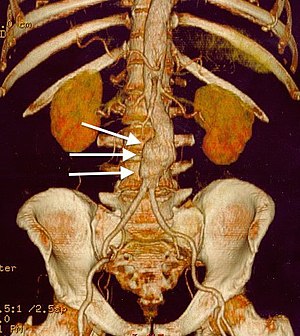Abdominal aneurysm
| Abdominal aortic aneurysm | |
|---|---|
| Synonyms | triple-a |
 |
|
| CT reconstruction image of an abdominal aortic aneurysm (white arrows) | |
| Classification and external resources | |
| Specialty | Vascular surgery |
| ICD-10 | I71.3, I71.4 |
| ICD-9-CM | 441.3, 441.4 |
| OMIM | 100070 |
| DiseasesDB | 792 |
| MedlinePlus | 000162 |
| eMedicine | med/3443 emerg/27 radio/1 |
| MeSH | D017544 |
Abdominal aortic aneurysm (AAA or triple A) is a localized enlargement of the abdominal aorta such that the diameter is greater than 3 cm or more than 50% larger than normal diameter. They usually cause no symptoms except when ruptured. Occasionally, abdominal, back, or leg pain may occur. Large aneurysms can sometimes be felt by pushing on the abdomen. Rupture may result in pain in the abdomen or back, low blood pressure, or loss of consciousness, and often results in death.
AAAs occur most commonly in those over 50 years old, in men, and among those with a family history. Additional risk factors include smoking, high blood pressure, and other heart or blood vessel diseases. Genetic conditions with an increased risk include Marfan syndrome and Ehlers-Danlos syndrome. AAAs are the most common form of aortic aneurysm. About 85% occur below the kidneys with the rest either at the level of or above the kidneys. In the United States, screening with ultrasound is recommended for males between 65 and 75 years of age with a history of smoking. In the United Kingdom, screening all men over 65 is recommended. Once an aneurysm is found, further ultrasounds are typically done on a regular basis.
Not smoking is the single best way to prevent the disease. Other methods of prevention include treating high blood pressure, treating high blood cholesterol and not being overweight. Surgery is usually recommended when an AAA's diameter grows to >5.5 cm in males and >5.0 cm in females. Other reasons for repair include the presence of symptoms and a rapid increase in size (more than one centimeter per year). Repair may be either by open surgery or endovascular aneurysm repair (EVAR). As compared to open surgery, EVAR has a lower risk of death in the short term and a shorter hospital stay, but may not always be an option. There does not appear to be a difference in longer term outcomes between the two. With EVAR there is a higher need for repeat procedures.
...
Wikipedia
